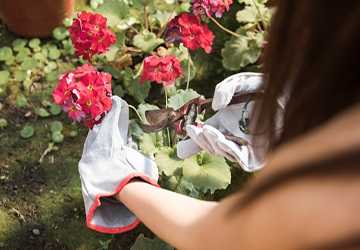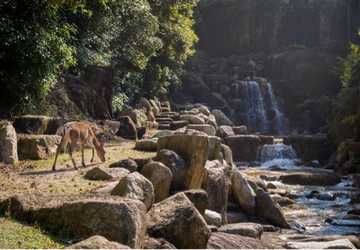Gardens are a source of beauty, relaxation, and joy for many of us. Whether you have a green thumb or enjoy the sight of flourishing flora, your garden is a cherished space. However, if you are a pet owner, especially if you have grazing pets like rabbits, guinea pigs, or even free-roaming chickens, you must be vigilant about the plants you cultivate. Many common garden plants can be toxic to our furry or feathered friends, threatening their health and well-being. This article will explore the top 10 garden plants harmful to grazing pets and learn how to keep our beloved animals safe.

Garden Plants Harmful to Grazing Pets: What to Watch Out For
Gardens are a sanctuary of serenity and splendour, a haven for those seeking solace in embracing nature's beauty. Yet, gardens can harbour hidden dangers for pet owners, especially those with curious grazing animals. Many charming plants that adorn our outdoor sanctuaries can be toxic to our furry and feathered companions, potentially jeopardizing their health and well-being. This article will uncover the top 10 garden plants perilous to grazing pets. Our mission is to educate you on these threats and provide valuable insights on safeguarding your cherished animals, ensuring they can roam and graze freely without fear.
Azaleas
With their vibrant and enchanting flowers, Azaleas are popular in many gardens. However, they are also highly toxic to pets when ingested. These plants contain grayanotoxins, which can cause drooling, vomiting, diarrhoea, and, in severe cases, lead to cardiac issues. Keeping azaleas out of their reach is crucial if you have grazing pets.
Oleander
Oleander, a beautiful and drought-resistant shrub, is a garden favourite. Yet, every part of this plant is toxic to pets. Ingesting oleander can lead to symptoms like vomiting, diarrhoea, heart problems, and, in extreme cases, death. Ensure your grazing pets are far away from this alluring but deadly plant.
Lily of the Valley
Lily of the Valley is known for its delicate and sweetly scented white bells. However, its beauty conceals a dark secret. These charming flowers contain cardiac glycosides, which can disrupt your pet's heart rhythm, leading to vomiting, seizures, and potentially fatal consequences. Keep your pets safe by avoiding this plant in your garden.
Daffodils
Daffodils are a cheerful sign of spring, but their bulbs contain alkaloids that are toxic to pets. If your furry friends ingest them, it can result in nausea, vomiting, diarrhoea, and, in some cases, more severe complications. It's best to plant daffodils in areas your pets cannot access.

Foxglove
Foxgloves are tall, elegant plants that add a touch of elegance to any garden. However, they contain chemicals called cardiac glycosides, which can disrupt your pet's heart rhythm and lead to severe health issues. Ingestion of foxgloves can cause vomiting, diarrhoea, and even death. To keep your pets safe, it's wise to avoid planting these in your garden.
Oleander
Oleander, a beautiful and drought-resistant shrub, is a garden favourite. Yet, every part of this plant is toxic to pets. Ingesting oleander can lead to symptoms like vomiting, diarrhoea, heart problems, and, in extreme cases, death. Ensure your grazing pets are far away from this alluring but deadly plant.
Rhododendron
Rhododendrons are known for their striking, colourful blossoms that light up gardens in the spring. However, these plants contain grayanotoxins, which can harm grazing pets. Ingesting rhododendron leaves can cause drooling, nausea, and more severe complications, so preventing your pets from snacking on these shrubs is vital.
Hydrangea
Hydrangeas are beloved for their large, globe-like flowers and vibrant colours. Yet, the leaves and buds of this plant contain cyanogenic glycosides, which can cause vomiting, diarrhoea, and stomach pain in pets. While not usually life-threatening, keeping your animals away from hydrangea plants is best.
Hemlock
Often mistaken for parsley or other edible herbs, Hemlock is a highly poisonous plant. The toxins in Hemlock, such as coniine and gamma-conceive, can lead to paralysis and, in severe cases, death when ingested. To ensure your pets are safe, never cultivate Hemlock in your garden, and be cautious of its presence in the wild.
Nightshades
Nightshade plants, including tomatoes, potatoes, and eggplants, are common in gardens and kitchens. Ingestion can lead to symptoms like gastrointestinal distress, confusion, and tremors. While it's rare for pets to eat these parts, monitoring your animals around nightshade plants is still essential.
Protecting Your Grazing Pets
You can use fencing or netting to protect your pets from potentially toxic plants. It's also important to educate yourself about the plants in your garden and their potential risks. Regularly checking for new growth or changes in your existing plants can help you stay informed. Supervising your pets in the garden ensures they are not nibbling on hazardous plants. When selecting new plants for your garden, research their safety for pets and opt for pet-friendly varieties to reduce risks. If you are concerned about your pets' safety, consider creating raised beds or vertical gardens. These can help keep toxic plants out of your pets' reach. Lastly, contact your veterinarian immediately if you suspect your pet has ingested a poisonous plant. They can guide necessary treatment.
Conclusion
Gardens should be a place of delight and relaxation for humans and their pets. However, with many beautiful but toxic plants, you must be cautious about what you cultivate. Understanding the dangers of common garden plants like azaleas, oleander, and daffodils and protecting your grazing pets can ensure your garden remains a safe and harmonious space for all its inhabitants. Gardening and pet ownership can go hand in hand as long as you prioritize the health and well-being of your beloved animals.














